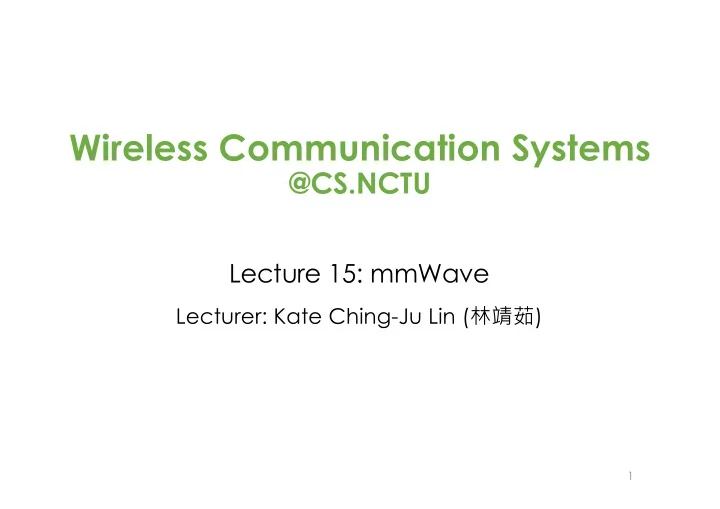

Wireless Communication Systems @CS.NCTU Lecture 15: mmWave Lecturer: Kate Ching-Ju Lin ( 林靖茹 ) 1
Millimeter Wave Bands • Huge amount of available bandwidth ( λ =C/f) 2
mmWave Wireless Applications 5G Cellular Networks Wireless Data Centers Wireless LANs 802.11ad Connected Vehicles Wireless Virtual/ Augmented Reality 3 Gesture Recognition
• Between 30GHz and 300GHz • Offers much greater bandwidths combined with further gains via beamforming and spatial multiplexing • Antenna arrays: Enable large numbers (32 elements) of miniaturized antennas placed in small dimensions • Increasing omnidirectional path loss due to the higher frequencies of mmWave transmissions ⎻ Compensated through suitable beamforming and directional transmissions ⎻ Severely vulnerable to shadowing (blockage) 4
Challenges • Directional communications • Shadowing • Channel fluctuation • Multiuser coordination • Power consumption 5
Directional Transmissions • Path loss grows with the square of the frequency • Small wavelength à Large path loss à Short transmission range • Leverage antenna array and beamforming to steer directional beam with a stronger power • Deafness occurs when the main lobes at both Tx and Rx do not point to each other 6
Shadowing • mmWave signals are extremely susceptible to shadowing ⎻ High penetration loss due to obstacles ⎻ Brick can attenuate signals by as much as 40–80 dB 7
Channel Fluctuation • For a given mobile velocity, channel coherence time is linear in the carrier frequency à higher frequency, shorter coherence time ⎻ Connectivity will be highly intermittent and communication will need to be rapidly adaptable ⎻ Channel estimation should be performed frequently à large overhead 8
Multiuser Coordination • Directional transmissions imply more spatial reuse opportunities • Challenges ⎻ How to locate users? ⎻ How to quickly switch the beam directions and widths? 9
Power Consumption • Power consumption generally scales ⎻ linearly in the sampling rate ⎻ exponentially in the number of bits per samples • Hard to achieve high-resolution quantization at wide bandwidths and large numbers of antennas • Efficient RF power amplification and combining will be needed for phased array antennas 10
Phase Array mmWave radios use phased antenna arrays to focus the power along one direction Small Wavelength enables thousands of antennas to be packed into small space à Extremely narrow beams
Beam Searching 𝑂 : number of possible directions AP Client 𝑂 𝑂 directions Naïve solution: Exhaustive search O 𝑂 - Beacon Packets à Too expensive
802.11ad: Multi-Stage Scan • Stage 1: Client uses omni-directional; AP scans directions Client AP
802.11ad: Multi-Stage Scan • Stage 2: AP uses omni directional; client scans directions AP Client O( 𝑂 ) Beacon Packets Still Too Slow [MOBICOM’14, SIGMETRICS’15, NSDI’16]
Hybrid Precoding • Iteratively reduce the size of lobes as scanning AP Client 15
Hybrid Precoding • Iteratively reduce the size of lobes as scanning AP Client 16
Hybrid Precoding • Iteratively reduce the size of lobes as scanning • Until the narrowest beam pointing to each other AP Client 17
Recommend
More recommend